This was the spectacle that colonized our dreams.

He was the most famous American in the world — a showman and spin artist who parlayed a buffalo-hunting gig into an entertainment empire. William F. Cody’s stage show presented a new creation myth for America, bringing cowboys, Indians, settlers, and sharpshooters to audiences who had only read about the West in dime novels. He offered Indians a life off the reservation — reenacting their own defeats. Deadwood producer David Milch explains why the myth of the West still resonates; a Sioux actor at a Paris theme park loves playing Sitting Bull; and a financial executive impersonates Buffalo Bill, with his wife as Annie Oakley.
_CREDIT%20Arthur%20Amiotte.jpg)
Bonus Track: Indian or Native American?
Artist and scholar Arthur Amiotte offers his opinion on the names given to — and chosen by — his people.
Video: "Buffalo Bill's Wild West"
There's not much video of Buffalo Bill; William Cody couldn't quite figure out how to adapt his "Wild West" show to the new technology of film. But Thomas Edison used the developing medium to capture some amazing footage of the show.
Video: “La Légende de Buffalo Bill”
The "Wild West" show has history in Europe. The original stage show spent perhaps a third of its run across the Atlantic, touring as far east as the Ukraine. As shown in the promotional video below, a current French incarnation — "with Mickey and friends" — draws heavily on the mythology created by Buffalo Bill.
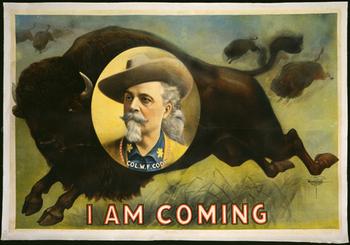
The arrival of "Buffalo Bill's Wild West" show was always a spectacular event, and William Cody knew how to promote it. This poster advertises the show by emphasizing Cody's connection to buffalo hunting and the frontier.
(Buffalo Bill Historical Center, Cody, Wyoming; Museum Purchase, 1.69.4922)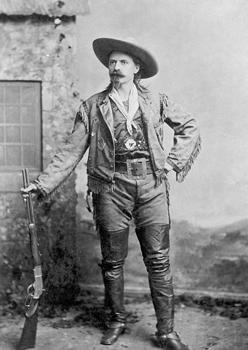
William F. Cody helped mythologize the American West as “Buffalo Bill.” His typical costume of a Stetson hat, beaded and fringed buckskin jacket, and thigh-high boots would become the template for the romanticized image of the Western cowboy.
(Buffalo Bill Historical Center, Cody, Wyoming; Original Buffalo Bill Museum Collection, P.69.923)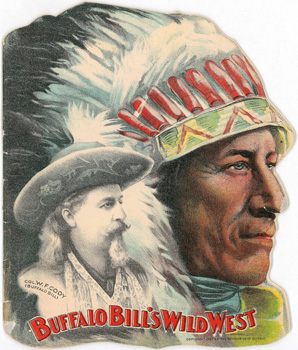
The “Wild West” show staged reenactments of America’s past, but also crafted mythological storylines, most significantly “Cowboys versus Indians.” This program from a 1907 show features Buffalo Bill and an Indian chief, who for a time was played by the real-life Lakota Chief Sitting Bull.
(Buffalo Bill Historical Center, Cody, Wyoming; Buffalo Bill's Wild West 1907 Courier)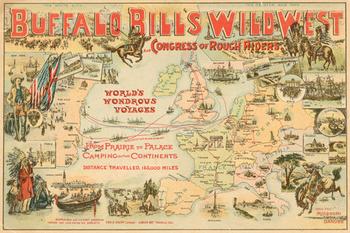
During its three-decade run, “Buffalo Bill’s Wild West” toured around the world, as far east as the Ukraine.
(Buffalo Bill Historical Center, Cody, Wyoming; MS6.6.A.4.9.1.01a)
A poster advertising “Buffalo Bill’s Wild West and Congress of Rough Riders of the World” links the trick riding performed during the show to the idea of the western frontier.
(Buffalo Bill Historical Center, Cody, Wyoming; Gift, 1.69.1813)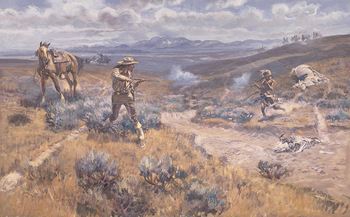
Buffalo Bill’s Duel with Yellowhand, by Charles M. Russell, c. 1917. The painting depicts an actual confrontation in which William Cody took a man’s scalp, but in the story Cody told for the stage, his victim grew in significance to become a chief who had killed General Custer.
(Courtesy Sid Richardson Museum, Fort Worth, Texas)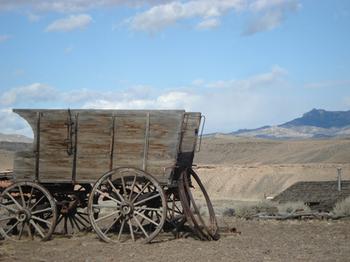
A recreated ghost town on the outskirts of Cody, Wyoming. William Cody founded his namesake town in 1896, after he made his fortune in show business.
(Leital Molad)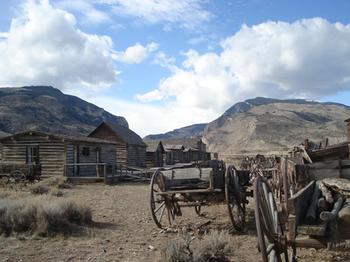
The ghost town on the edge of Cody, Wyoming is the site of the original Cody settlement. It has a frontier feel, but many of the buildings were imported from other ghost towns.
(Leital Molad)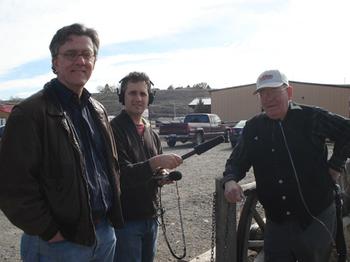
Ray Hammond (far right) is the caretaker of the Cody ghost town. He showed Kurt Andersen (left) and producer Eric Molinsky (middle) around the site.
(Leital Molad)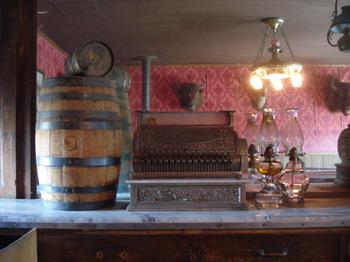
The Cody ghost town is a meticulous presentation of an imagined Wild West, complete with ramshackle saloon.
(Leital Molad )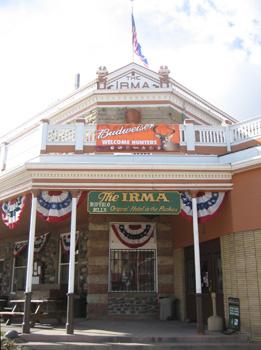
Old Cody meets new Cody: at the Hotel Irma, a modern advertisement invites hunters to the bar, but the upstairs guest rooms are authentic to those of 100 years ago.
(Leital Molad)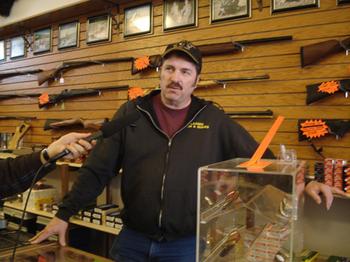
Mark Paul runs the gun shop in downtown Cody, Wyoming. He says Cody is a unique place, where “firearms laws are very, very minor.”
(Leital Molad)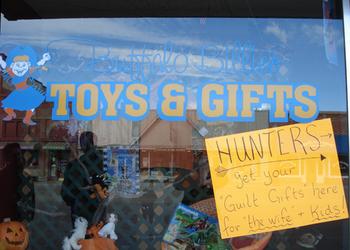
Buffalo Bill’s stamp can be seen throughout the shops of downtown Cody, Wyoming, including Buffalo Billie’s Toys and Gifts.
(Leital Molad)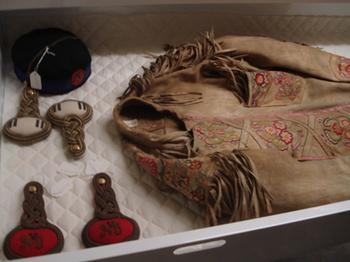
William Cody played a version of himself in the “Wild West” show: he really was a cavalry scout who tracked Indians for the United States Army. But the frills and embroidery on his coat are nothing like what actual cowboys wore. This costume, worn by Cody, is stored in the archives of the Buffalo Bill Historical Center.
(Leital Molad)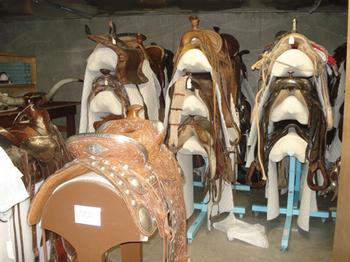
A collection of Cody’s show saddles in the archives of the Buffalo Bill Historical Center.
(Leital Molad)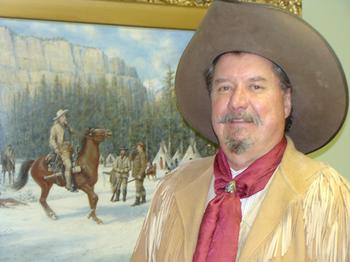
RD Melfi — a vice president at Wells Fargo Bank — is an award-winning reenaactor who’s been studying and portraying Buffalo Bill since he was seven years old. Here he poses with the painting that inspired his boyhood fascination.
(Megan Verlee)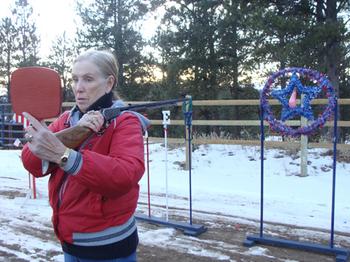
RD Melfi’s performing partner is his wife, Barbara Melfi, who portrays Annie Oakley. Here she takes aim for Oakley's signature over-the-shoulder trick shot.
(Megan Verlee)
Success! The paper blank bursts the balloon in Barbara Melfi’s trick. Trick shooting was also an important part of Annie Oakley’s routine in “Buffalo Bill’s Wild West.”
(Megan Verlee)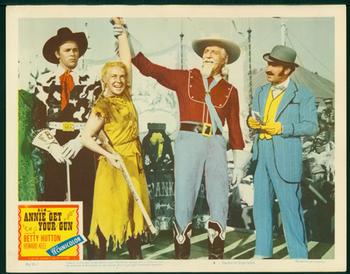
The characters and narratives from Buffalo Bill’s Wild West would survive on film for decades after the show’s demise. One of the most enduring personas was Annie Oakley, as seen in the 1950 movie musical Annie Get Your Gun.
(© Dickinson Research Center, National Cowboy & Western Heritage Museum, Oklahoma City, Oklahoma; MGM)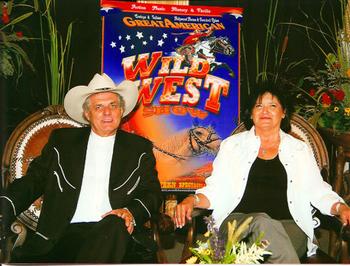
Don and Sharon Endsley’s “Great American Wild West Show” is a contemporary version of Buffalo Bill’s show, held at rodeos around the country.
(Courtesy of Don Endsley's “Great American Wild West Show”)
Endsley’s show uses many of the elements of Cody’s show, including a stagecoach. The six-horse stagecoach in Endsley’s production enters the arena at 35 miles per hour to open the show.
(Courtesy of Don Endsley's “Great American Wild West Show”)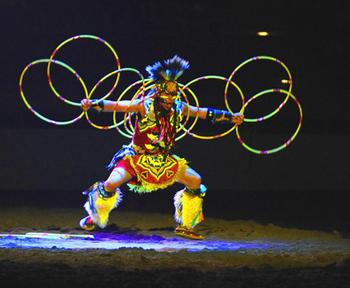
Like “Buffalo Bill’s Wild West,” the “Great American Wild West Show” incorporates Indians performing their traditional dances. Brian Hammell is a world-champion hoop dancer whose dancing has been passed down through generations.
(Courtesy of Don Endsley's “Great American Wild West Show”)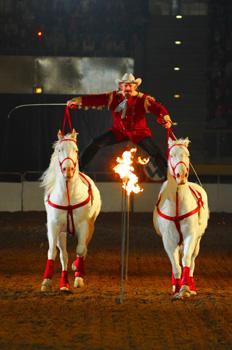
Max Reynolds performs a trick known as “Roman Riding,” in which he straddles two horses that are not tied together. Trick riding was also a central part of “Buffalo Bill’s Wild West.”
(Courtesy of Don Endsley's “Great American Wild West Show”)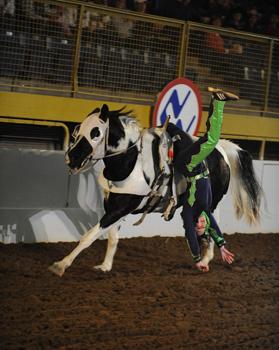
More trick riding: Haley Ganzell — 16 years old — performs the Cossack Death Drag.
(Courtesy of Don Endsley's “Great American Wild West Show”)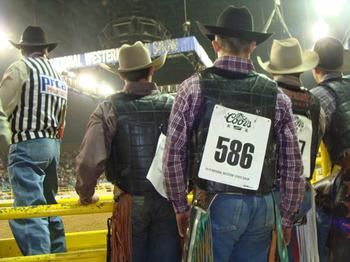
The modern rodeo is also influenced by Cody. These bronco riders all wear the Stetson-style hats popularized by Buffalo Bill as they await their turn to compete at the National Western rodeo.
(Megan Verlee)
A rider contemplates a bull at the National Western rodeo. Buffalo Bill’s influence on professional rodeo can be seen in the frills on the rider’s chaps.
(Megan Verlee)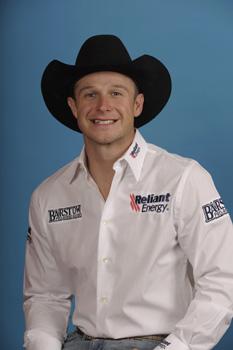
Clint Cannon is a world champion bareback rider. The cowboy identity first established by Cody is essential to his work: “We're from the country, but we didn't know how to be a real, legit cowboy — dress the part, act the part, be real about it."
(Courtesy of The Professional Rodeo Cowboys Association)
The original “Wild West” show was a hit in Europe. A modern incarnation — “La Légende de Buffalo Bill” — is still performed today at Parc Disneyland, outside of Paris.
(© Disney)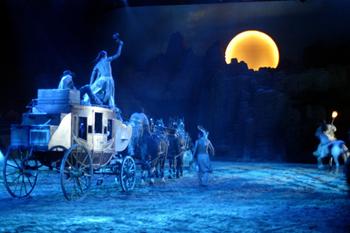
An Indian attack on a stagecoach, as performed in “La Légende de Buffalo Bill” at Parc Disneyland in France.
( © Disney)
The Parc Disneyland “Wild West” show incorporates live buffalo.
(© Disney)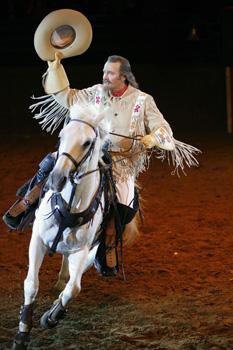
The iconic character of Buffalo Bill is an important part of the Parc Disneyland show.
(© Disney)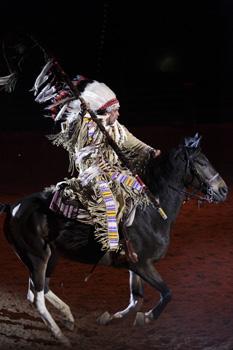
And so is the character of Sitting Bull, portrayed here by Kevin Dust. The real Sitting Bull appeared in the original “Wild West” show, but only for a few months.
(© Disney)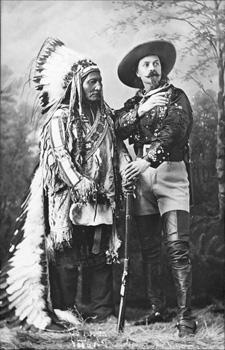
Sitting Bull together with William Cody. While performing as enemies in the show, the two became good friends.
(Buffalo Bill Historical Center, Cody, Wyoming; Gift of D.F. Barry, P.69.2127)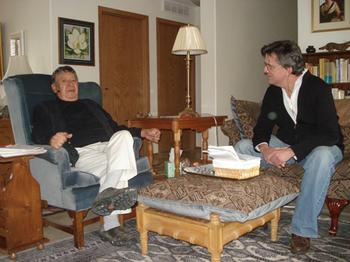
Kurt Andersen visits renowned artist and scholar Arthur Amiotte at his home in Custer, South Dakota. Amiotte is a descendant of one of the Indian performers in Buffalo Bill’s show.
(Leital Molad)
While on tour with the Wild West, Arthur Amiotte’s great grandfather Standing Bear encountered the cities of late nineteenth-century Europe as a naïve outsider. Amiotte’s collage paintings draw from his ancestor’s experiences abroad, juxtaposing traditional Indian images with more modern images.
(Janet Berlo)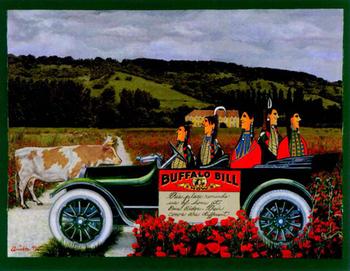
One of the themes of Amiotte’s art is the active participation of American Indians in the modern world. One Cow (1999) places Indians in European landscapes, referencing the Lakota who toured Europe with “Buffalo Bill’s Wild West.”
(Arthur Amiotte)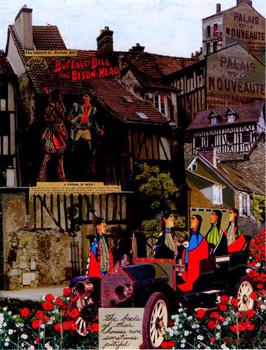
The captions of Amiotte’s collage paintings present reactions — and sometimes judgments — by American Indians traveling through Europe. The Lakota commenter of In the Alley in France (1999) is surprised to find “the backs of their houses were sometimes pitiful.”
(Arthur Amiotte)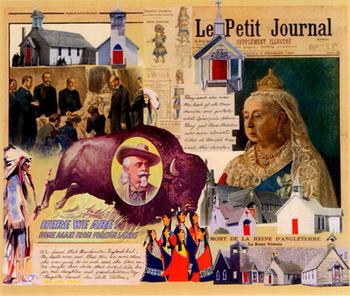
Protector of the Faith (2001) by Arthur Amiotte
(Arthur Amiotte)
The Grace of White Culture, Technology, and Religion (1989) by Arthur Amiotte
(Arthur Amiotte)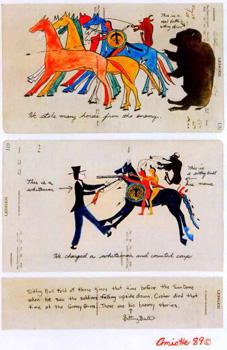
Sitting Bull’s Ledger II (1989) by Arthur Amiotte
(Arthur Amiotte)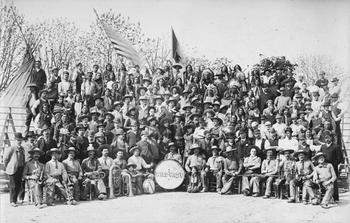
“Buffalo Bill’s Wild West” provided many American Indians the only outlet to perform their traditional dances, creating what Arthur Amiotte views as a tension between preservation and perversion of Indian culture. The significant presence of American Indian performers in the show is recorded in this 1890 cast and personnel photo, taken in Milan.
(Buffalo Bill Historical Center, Cody, Wyoming; Original Buffalo Bill Museum)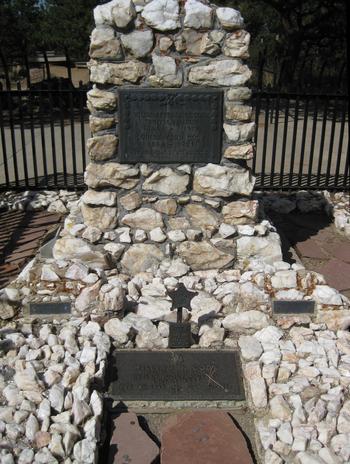
William F. Cody’s grave on Lookout Mountain, west of Denver. Cody’s legacy endures in America’s love affair with the mythological West.
(Jacqueline Cincotta)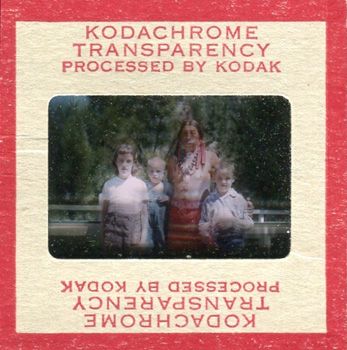
Kurt Andersen (second from left), with siblings, Kristi (left) and David (right), visited the Black Hills of South Dakota as a child. Like many Americans his age, Kurt grew up playing “Cowboys and Indians,” regularly reenacting roles first sketched out by “Buffalo Bill’s Wild West.”
(Courtesy of Kurt Andersen)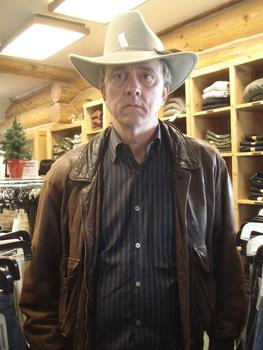
Kurt Andersen tries on a Stetson. Spend enough time in Cody, Wyoming and you’ll start looking like a cowboy, too.
(Leital Molad)BILLBOARD
CUE: WILD WEST MUSIC
The cowboy. He is the great American hero. But the cowboy as we know him didn’t really exist until Buffalo Bill invented him in his Wild West show.
LW: He helped transform cowboys into a good working man hero.
I’m Kurt Andersen. In this hour of American Icons, we'll look at how Buffalo Bill's Wild West transformed our popular culture, and helped re-define the American story.
RS: Buffalo Bill’s Wild West will come to your city….and you will visually see this mythic story played out.
INDIAN SFX
And we’ll hear from Native Americans whose ancestors performed in the show – some say, to preserve their culture.
AA: And then there are those who would say these were a means of perverting these traditional activities also.
Put on your boots and saddle up. We’re heading out West. That’s all ahead in Studio 360’s American Icons, right after this.
SEG A
This is Studio 360, I’m Kurt Andersen.
CLIP: ”Long live Cowboys!”
America is a cowboy nation. We love our guns, the wide open spaces and the idea of the lone rugged hero.
Even our politicians sound like cowboys before they become leaders
REAGEN: Our casualties were heavy…
and after.
BUSH: Smoke ‘em out.
The Wild West is a fundamental part of how we built this nation. Of course, the real history wasn’t so romantic. It was complicated, and sometimes grim.
So where did this mythology come from? Sure, there was John Wayne and a gazillion Westerns, but who came before that? Where did it all start?
ANNIE GET YOUR GUN: Who’s got the show that has the most applause?! 500 Indians and 50 Squaws. 10 featured acts and there’s a special feature still. Who?! Col. Buffalo Bill!
Buffalo Bill Cody. If you know anything about him, it's probably from the musical "Annie Get Your Gun."
But Annie Oakley was only one character in Buffalo Bill’s parade of cowboys, Indians, and settlers. They all made up Buffalo Bill's Wild West, a live entertainment spectacle that traveled the world for three decades.
In this hour of our series on American Icons, we’re going to look at how Buffalo Bill's Wild West changed the way we Americans understand our history and our destiny.
But to fully understand the show, we have to start with the man behind it.
How did William F. Cody become “Buffalo Bill?”
KA: So here we are on the Western edge of town, and we see the beginnings of the theme of town: Old Trail Town, the old West as it really was...[FADE DOWN]
I figured the best place to learn about William Cody was Cody, Wyoming -- the town he founded in 1896, after he made his fortune in show business.
KA: Cowboy Village
Cody wasn’t much of a family man; he traveled with his Wild West show for thirty years. But he did name the oldest building in town after his youngest daughter: The Irma Hotel.
TEEN: The most common question we get is, “where are the bullet holes in bar?”
KA: Are there bullet holes in the bar?
TEEN: Yes, there are one or two by Buffalo head up there.
WAITRESS: A handshake is a bond, it’s like the old west, it is.
KA: Have you always worn cowboy hat?
COWBOY: Yes sir, all my life, except when in bed. Yeap.
MARK: There’s no place like Cody.
Mark Paul runs the local gun shop
MARK PAUL: Firearms laws are very, very minor and non-existent in many cases. It’s great.
KA: Is this your son sweeping up outdoors?
MARK: That’s Donny.
KA: You’re Donny? Do you know who Buffalo Bill was?
DONNY: Yeah.
KA: What do you think of Buffalo Bill?
DONNY: He was a great man.
A great man? Maybe. William F. Cody began his career an army scout in the 1870s, tracking Indian tribes on the run from the U.S. Cavalry. He was a skilled rider and expert buffalo hunter – hence the nickname. Eventually he was sought out by rich people looking for thrills on the frontier. He took them out on buffalo hunts.
JOHN RUMM: And this robe of buffalo and other furs was given to Cody by the grand duke to thank him for that experience.
John Rumm curates the Buffalo Bill Historical Center in Cody. He’s showing me a robe of buffalo furs that was given to Cody by the Grand Duke of Russia. Cody sold himself as a rugged frontiersman, but he really wanted to be a star.
JR: That hunt was widely covered in all the papers.
KA: He was a young man, 25, 26
JR: That’s right in 1872 he would’ve been about 25, 26.
KA: This was his big break?
JR: That was his big break.
Before long, dime novels and newspaper articles featured Buffalo Bill – or at least an enhanced fictional version of him.
That same year Cody was invited to perform in a stage show in Chicago. Who did he play? Himself. And the show was such a hit it moved to New York.
Louis Warren is the author of “Buffalo Bill’s America.” He says Cody was our first modern American celebrity.
LOUIS WARREN: Cody’s one of the first people who figures out earliest in this period I think, that you could live your whole life as an ongoing drama for a large audience, or you could at least make it look like that’s what you were doing. And that was a way to make a living out of living, in a sense.
In the summer of 1876, when Cody was 30, his real life and his performance art collided. He was scouting with the 5th Cavalry out of Fort Robinson in western Nebraska when he came across a Cheyenne warrior called Yellow Hair.
JUTI WINCHESTER: Yellow Hair and Cody probably took shots at each other. And might have shoot horses out from each other, but they did get into hand to hand fight
Historian Juti Winchester lives in the town of Cody.
JW: Whether or not there was any dialogue, “oh Pawhuska I know you!” You know and “Come and get me!” Or whatever they were saying. But there was hand-to-hand fight and in the end, Cody did take a man’s scalp in this.
KA: And was it true that he was dressed in the theatrical Buffalo Bill outfit?
JW: Yeah, he was dressed in a black...black velvet mariachi style suit, on The Plains in July! Can you imagine this? He must have been hot and uncomfortable but he was going to do it because then he could go back to the stage and say “in this costume I performed these deeds.” Whether or not he planned on killing somebody specific like that, I don’t believe.
When Cody got back to New York, he claimed this unfortunate random guy he’d come across was actually an Indian chief -- one of the Indians who’d just killed General Custer and all his soldiers at the Battle of Little Big Horn.
This real human scalp, and the phony story behind it, became a sensational new prop in Cody's stage show.
LW: Cody’s entertainment plays on Americans longing for real things, to know they are in touch with something authentic and not just a copy. But throughout his entertainment, he was always surrounding himself with things that were inauthentic and he told many stories were mostly or in some cases completely fabricated.
SLOTKIN: And then he gets this idea of combing the rodeo with what he used to do as a stage performer,
Richard Slotkin is the author of the book "Gunfighter Nation."
RICHARD SLOTKIN: and that’s the origin of the Wild West formula.
On May 19, 1883, at the age of 43, Cody put on the first Wild West show in Omaha, Nebraska – my hometown.
Most Americans had only read or heard about the West – the ranchers, the pioneers, the Indians. Cody was brining the West to them -- while the Indian Wars were still being fought.
LW: It was a huge operation. The show took three trains to move all of the staff, the cast, the animals, and the props. The Wild West show had its own pastry chef, it had its own blacksmiths, it had it had its own wheelwright, it had it’s own corps of electrical engineers. So there would be -- during it's peak years -- between 700-1200 people traveling with the Wild West show.
From the moment the Wild West show debuted, audiences flocked to it -- Hundreds, thousands at a time from immigrant workers to upper class ladies.
LW: You’d probably show up early, because if you showed up early you got to walk through Wild West village that was there and particularly the Indian encampment, where you would actually meet genuine Indians who were in the show, and then you go sit in the stands.
BOB RYDELL: The grandstand takes the form of a horseshoe.
Historian Bob Rydell
BOB RYDELL: And on one end is an enormous tableau, a painting that depicts mountains, it depicts um, recognizable western scenes.
MUSIC: Star spangled banner
JW: Well the first thing you’d be struck by is the music. And Cody had a cowboy band.
LW: It began with Star Spangled Banner typically. The show used the Star Spangled Banner long it before it became the national anthem.
LW: You would have almost like an introductory bit where everyone would ride around the arena.
SFX: Horses hooves, crowd clapping.
LW: And then there would be a whole series acts of skill and competition.
RS: Plus also feats of marksmanships, since Cody was a noted marksman, with several different kinds of weapons. He would give a display of shooting glass balls thrown into the air while riding by on horseback.
SFX: Crowd and gunshots, glasses smashing.
RS: The Wild West, he says it’s not a show, it’s not simply a stage performance; it’s a reenactment of American history. So he’ll begin with let’s say, the landing of the Pilgrims at Plymouth Rock, or he’ll restage John Smith and Pocahontas, but what he does then is he cuts from that primal moment to the Wild West.
BR: The high point of the show is the Deadwood stage, and this chase around the arena. The end of the show you know civilization is safe…through the good graces of Buffalo Bill and the western cowboys.
SFX: Horses racing and cowboys yelling
RS: Buffalo Bill’s Wild West will come to your town, Buffalo Bill’s Wild West will come to city, and you will visually see this mythic story played out with, as Cody says, with the original performers. He gets Sitting Bull to perform in his show. He gets Geronimo to perform in his show.
LW: And his show went not just the United States, the show spent almost ten years touring Europe, and it went as far East as what is today the Ukraine. Buffalo Bill was the most famous American in the world.
Authentic or not: Buffalo Bill’s Wild West became a new creation myth for America.
Coming up, we meet Old West re-enactors who are trying to keep Cody’s memory alive in the 21st century.
CLIP: "I feel like the Old West is an endangered species."
Later on, Sioux chief Sitting Bull: alive and well, and living in Paris.
KEVIN: They expect me to be a chief so I have to present myself respectable, ah you know stoic or whatever they’re looking for, and I give them all that.
You’re listening to Studio 360’s American Icons hour on Buffalo Bill’s Wild West show. Stay with us.
SEG B
MUSIC: WILD WEST SHOW
KA: I’m Kurt Andersen. Today in Studio 360, we’re looking at the legacy of Buffalo Bill’s Wild West show, the first global entertainment spectacle, which toured the world for more than 30 years starting in the 1880s.
In Buffalo Bill Cody’s time, cowboys were nothing like clean-cut rodeo stars or country singers or the Lone Ranger. They were more like the Hell’s Angels of the Great Plains on horseback.
JW: They were a rough bunch. And they were day laborers, doing hard work, living hard, they were singles guys for the most part and living that life.
Historian Juti Winchester says it was Buffalo Bill who rebranded the cowboy as respectable, inventing that “yes ma’am” code of honor.
JW: He helped transform cowboys into heroes of a certain kind, good workingman heroes.
American cowboys didn’t wear Stetson hats until Cody made them popular. Real cowboys were often black or Mexican. Cody’s cowboys were overwhelmingly white. Real cowboys were simple ranch hands. Cody’s cowboys were super marksmen, trick riders and ropers. And they had really good hygiene.
JW: The cowboys in the Wild West when they weren’t dirty from the arena, when they went around town they were perfectly clean, they were straight laced.
Some people are still trying to live up to Buffalo Bill’s image of the Western hero. Out in Denver Colorado Public Radio's Megan Verlee met with some of them.
MEGHAN VERLEE: I’m on the backyard of R.D. Melfi’s house in Denver. R.D. has Cody's pointed blond beard, his shoulder-length hair and his fondness for buckskins. During the week he's a vice-president at Wells Fargo. But on the weekends he cleans up on the reenactment circuit.
RD MELFI: I have been actually studying and portraying Buffalo Bill since I was a little boy, maybe 7 or 8 years old.
MV: RD's wife performs alongside him.
BARBARA MELFI: I'm Barbara Melfi and I have been portraying Annie Oakley for 15 years now and I love every minute of it.
MV: Annie Oakley was the biggest star that came out of the Wild West show, an unbelievably good sharp shooter who managed to be rugged and ladylike. Barb is able to reenact Oakley's tricks with darn good accuracy.
RD: Now Ladies and Gentlemen, this shot is called the Annie Oakley. Annie is sighting in, using a mirror, with the rifle over her shoulder. So she's sighting into that target with that mirror. <shot> Woo, nice shot, Annie!
MV: It's an early winter evening. At eight thousand feet, the temperature drops fast when the sun goes down. We tramp back to the Melfi's house. Inside it's a shrine to the Old West. And that's before you get to the room with all the reenactment gear.
SFX: rustling garment bags
BM: This is his latest one. This is his pride and joy. This is an exact replica. They copied it bead for bead.
MV: What Barb's pulled out here is her husband's magnificent beaded, buckskin jacket. If you're picturing Buffalo Bill right now, this is probably what he's got on.
RD: The coat is Buffalo Bill's vaquero jacket. He wore that quite a bit. There are quite a few photographs of him in this coat.
MV: The Melfis both grew up crazy about cowboys, at a time where pop culture agreed with them. Now their nostalgia has become a kind of activism.
RD: It's almost like an environmentalist who'll fight for little bitty fish or spotted owl or whatever. Well, I feel like old west is endangered species now. And... we fight against that constantly, trying to make people understand. That still has to live along with Starbucks Coffee and Burkenstock sandals and all the other foo-frah that goes along with whatever we call that culture <chuckles.>
MV: RD is going to keep up the fight for a very long time.
RD: Most of your famous characters, like Custer or Hickok, they died young. And when you start aging and get a little too old, you can't really do some characters. But with Cody, I mean I can do Cody til I'm 80, if I'm able. And you know hopefully people will still want to see Cody at 80.
SFX: The sights and sound and thrills of the Wild Wild West will come alive! This is the Great American Wild West Show spectacular!”
MV: One of the Melfi's main gigs is playing Buffalo Bill and Annie Oakley in the Great American Wild West Show – it's a stadium-sized attraction that’s part of Denver's Annual Stock Show and Rodeo.
MV: The man behind this new Old West spectacular is Don Endsley, a retired rodeo announcer.
DON ENDSLEY: We do have a lot of elements that Buffalo Bill had in his shows. We have the Indian dancers and we have the longhorn cattle. We have the stagecoach robbery that he had, the stagecoach holdup.
MV: Endsley is trying to bring a sense of theater back to the rodeo scene, which he thinks has become too much of a sport.
SFX: “Look at this a figure 8! Right around the arena. Like it? I bet you do....
MV: His teenage stunt performers standing perilously atop their saddles, slinging themselves far off to one side or another. These may be cowboy skills... but they're pretty far from anything you'd need on a ranch. Then again, a lot of the audience members wearing cowboy hats and boots have no experience working on a ranch either. Don Endsley doesn’t see a contradiction.
DE: A cowboy, even to be more generic I guess, a Western Way about you, is not I think where you come from or where you live. It's a state of mind, it's in your mind. If your from Long Island and you want to be a cowboy, well you can be a cowboy. That geographical location that you're born in, or live in, can't keep you from being a cowboy. The people who ended up in the West as cowboys, like Buffalo Bill, they didn't come from the West. A lot of them moved to the West and became what they became.
SFX: Street noise
If we leave Endsley's Wild West Show and make our way under the six thundering lanes of the I-70, we arrive at a rodeo coliseum. Don Endley’s Wild West show may be a novelty act, but the modern rodeo is just as mainstream as NASCAR. Buffalo Bill’s imprint can be found here too.
SFX: banging and cowbells with RODEO ANNOUNCER: "Clint Cannon coming off one of the most successful seasons any single cowboy's ever had…. Here we go!"
MV: Clint Cannon is a world champion bareback rider. He used to play football in college until he and his brother started practicing rodeo stunts they saw on TV.
CLINT CANNON: We're from the country, but we didn't know how to be a real, legit cowboy – dress the part, act the part, be real about it.
MV: He's climbing up on bulls and horses, risking life and limb, trying to make a career of it ... but he can't be a real cowboy until his clothes are right?
CC: I love Westerns. I've got tons of them and when I'm not feeling like a cowboy sometimes, cause I live close to the city, I live right outside Houston, and sometimes I'm like, 'Oh man, I just don't feel like a cowboy today.' I'll put in an old Western and watch it and it makes me feel like a cowboy. You know I'll put in an old boots and go out and ride my horse, just because I watched that Old Western.
MV: Being a cowboy isn't about herding cows anymore. It's about living up to an icon. In Denver, I’m Megan Verlee for Studio 360.
When I was growing up we idolized cowboys. They were the good guys. Indians were the enemy.
It was Buffalo Bill Cody who linked cowboys and Indians together in the pubic imagination. In the real West, they had little to do with each other. But in Buffalo Bill’s Wild West show, cowboys would save the day when Indians attacked a stagecoach or a settler’s cabin.
Kid: Say Buffalo Bill what are Indian kids like? What do they do? Do they have to go to school?
BB: Well they have to go to school but not inside like you.
Kid: What do they learn? Arithmetic?
BB: No, they learn to ride and fish and hunt and swim
Kid: Tell us about it Buffalo Bill.
BB: Well it's kinda hard to tell but if you kids could see 300 of them on galloping ponies with feathers flying, its something you'd never forget.
That was Joel McCrea as Buffalo Bill in an old biopic.
Back in the 1870s, America was still fighting and winning the Indian wars. But a lot non-native Americans at the time saw them more or less the way we do now: unfortunate, tragic, inevitable.
Bill Cody knew that ambivalence wouldn’t sell. He changed the narrative from a war of ethnic cleansing into exciting heroic fun for the whole family. His Indians were clearly "the bad guys."
But in fact, weirdly, at a time when Native Americans were being herded onto reservations wholesale, performing in Cody’s show was a way out for a few of them -- a lucky break.
LOUIS WARREN: If you went to Wild West show, you typically got as an Indian performer a wage of 25 dollars a month. You also had all your travel expenses paid. You got food and lodging while you were on the road, and you got to see the world.
Louis Warren says Native Americans working for the Wild West show were able to preserve their culture – ironically -- by reenacting their defeat.
LW: Remember this is a time when Indian culture is under relentless attack by the US government, it's it’s illegal to do dances, to do most dances on the reservations. Indians ceremonies are banned, the children are taken to boarding schools where their not allowed to speak their language. They're forced to speak English.
MUSIC: Unknown
One of the Indian performers was a girl named Rose Nelson. Rose had been born on the Pine Ridge reservation in 1880. She joined Buffalo Bill’s brand new show at the age of four. Decades later, she told her granddaughter, Marirose Morris, about her days with the show.
MARIROSE MORRIS: You know the Indians would attack the settlers or the wagon train. In fact her father played a role of the setter and his cabin was attacked by Indians... most of whom were relatives through his wife but they understood theater.
Rose knew the show’s narrative was bogus, especially the re-enactment of the battles of the Indian war. But this was the only venue she and her people had to do tribal singing and dancing full-bore -- not just to entertain white audiences, but for themselves.
MM: You know they had all those dime novels and things- the Buffalo Bill dime novels. And we were not always portrayed accurately. I think she enjoyed having people treat her as a peer and letting them know she felt she was a peer if not more.
It didn’t hurt that Rose became a child star. Cody renamed her Princess Blue Water, and she got to meet President Chester Arthur and Queen Victoria. These stories grew into family legend.
MM: Yes she was presented to the queen, and she was told prior to being presented to her that she would have to curtsy, she said she wouldn't, she said our people don’t bow to anybody. There is another story about her smacking the Prince of Wales. They said he was making fun of elders and laughed at them, so she smacked him one.
Even more surreal, Rose claimed that her baby sitter had been Annie Oakley.
MM: Annie Oakley would let her sometimes have a sleep over at her tent, if she wasn’t behaving, Annie Oakley didn’t feel bad about having to spank her.
SFX: WALKING TO ARTHUR'S DOOR, EXCHANGE HELLOS. How do you do? I'm Kurt Anderson
Arthur Amiotte is a professional artist who lives in the town of Custer, South Dakota, out in the Black Hills.
ARTHUR AMIOTTE: I like to say this is a photograph of typical Lakota family at the turn of the century. There's a mother, a father, a child, a grandmother, a grandfather, and an anthropologist.
Arthur makes witty collage about Native Americans traveling in Europe with the Wild West. Including his ancestor: Arthur’s own great-grandfather, Standing Bear, was one of Buffalo Bill’s Indian performers. Standing Bear had never been off the Plains or seen a city until Cody hired him.
AA: For some of them even staying in hotels was a frightful experience, you know, being enclosed in these buildings on the 3rd or 4th or 5th or 6th floor with people underneath you, trusting that the building wasn’t going to fall down.
KA: The only kind of analogous experience one could imagine today is if we were sent to other planet to live among intelligent beings.
AA: Believe me the Indian people entering and living in the urban areas of America and Europe were not necessarily participating in life with more intelligent beings. (Laughs) No, and then they would talk about seeing odd things like organ grinder, huh? Standing Bear had seen this little creature and they didn’t know what it was, called it a Shunkawechacha, a dog man, they didn’t know what a monkey was. I mean they were talk about these, talking about the women wearing, well they didn’t know they were bustles. Those big things they wore in the back on their dress?
KA: They thought they had big butts?
AA: They thought they were deformed!
Standing Bear’s life was like some fish out of water comedy…but it was about to become a romantic drama.
In Vienna at the end of the 19th century, Standing Bear met Louise -- Arthur Amiotte’s great-grandmother.
AA: While in Vienna, Austria he was injured. And had to stay behind and we actually have the document where his ticket was left at American consulate....
KA: Was he injured as part of the show?
AA: Yes, he was injured during the show, and he had to stay behind and he was taken into home of the surgeon and his nurse. And the nurse was Louise Remmick, so he lived with them some say for almost two years. So she apparently was adept at learning languages, so she began learning Lakota from him while lived in their home. And it was at that time they began their liaison. However he had a prior wife who remained behind. She traveled, was with the Big Foot Band that got massacred at Wounded Knee. Once he heard the news that his first wife and baby daughter had been murdered at Wounded Knee, that’s when he decided then that he would ask Louise to be his wife.
KA: What a tale. And was it highly uncommon for these Indians traveling in Europe with Buffalo Bill's show to have relationships with Europeans?
AA: Absolutely, in fact it was frowned upon by white society, in particular.
KA: Do you think it’s fair to say that in some measure what the Wild West Show is doing, that one of its maybe unintended effects was to preserve Indian culture?
AA: There are those that would say that. And then there are those who would say these were a means of perverting these traditional activities by reenacting and doing them for a non-Indian audience that it was making them more and more into ah…
KA: Minstral versions of them?
AA: There you go. That’s good, minstrel versions of original.
KA: Both can be true I suppose, right? Preservation and perversion?
AA: Well, yes. If you look at the modern pow wow, and you see some of the outfits that the people are wearing. I mean gold lamay?!
Arthur Amiotte is an artist and teacher in South Dakota. And you can see some of his artwork at Studio 360.org.
CLIP: PARIS DISNEYLAND WILD WEST SHOW
Buffalo Bill’s Wild West was a blockbuster in Europe, spending maybe a third of its time there – and in France today something like it is still playing.
CLIP: PARIS DISNEYLAND WILD WEST SHOW CON’T
If you go to “Parc Disneyland” outside Paris, you can watch a live 90-minute Wild West show where they serve smoked ribs and chili.
FRENCH WOMAN/TRANSLATOR: Despite everything, despite the massacres and all that, it makes you want to go back and live the life of am Indian or a cowboy. To have a…a…
FRENCH MAN: A big adventure.
FRENCH WOMAN/TRANSLATOR: Yes!
“Despite the massacres.” That’s a large caveat. But nothing about the Wild West show is easy.
KEVIN DUST: Hello. My name is Kevin Dust, and I play the role of Sitting Bull.
Kevin Dust grew up on a reservation in Montana. Like his ancestors, Kevin found a new sense of freedom working in Europe.
KD: I was just going to the airport and I had one of my aunties, who is still upset to this day, asked where are you going? I said, well I'm going home... back to France. She was upset at me. And I wouldn't blame her, but again, it’s my second home. I quite like it here.
The character Kevin plays, Sitting Bull, was the most feared and admired chief during the Indian wars. And Sitting Bull actually appeared in Buffalo Bill’s original Wild West show…although only for a few months. Somebody has played Sitting Bull in the Paris Disneyland show for the last 16 years.
CLIP: DISNEYLAND SHOW
KD: They expect me to be a chief so I have to present myself respectable, you know stoic or whatever they’re looking for, and I give them all that. He’s been a chief of our tribe when he was only 27 year old. Here I am 47 myself thinking, well, it’s about time.
CLIP: DISNEYLAND SHOW
You know what they say about truth being stranger than fiction? That is a perfect description of the relationship between Buffallo Bill and Sitting Bull in real life. They became good friends even as they were playing enemies on stage.
JW: That makes perfect sense if you look at Buffalo Bill’s behavior before and after Sitting Bull.
Historian Juti Winchester
JW: When you look at things he said later on, I think Cody the man was staring to feel some regret at the way Native Americans in general were being treated, but also in his part in this.
After performing in the Wild West show, 59-year-old Sitting Bull returned to the Pine Ridge reservation in western South Dakota. On December 15th, 1890, he was arrested for inciting insurrection -- a charge that most historians say was spurious. The Feds called on Buffalo Bill to intervene.
JW: And Buffalo Bill with all honestly really meant to give a hand, but he got stopped. McLaughlin the agent was doing everything he could to throw objects into path of Buffalo Bill and he sadly threw some things that Buffalo Bill was weak to, including booze. Before Buffalo Bill could get to Sitting Bull it was all over.
Sitting Bull had been killed in a gun battle with police. His death led to the horrific massacre two weeks later at the Battle of Wounded Knee, the last great battle of the Indian wars.
In the Wild West show, Cody used to re-enact Sitting Bull’s victory over General Custer at the Battle of Little Big Horn. At the end of the scene, Cody would ride into the arena on horseback, carrying a banner that read “too late” -- as if he could’ve saved the hero Custer from Sitting Bull if he had only arrived in time.
In real life, it was Sitting Bull he had tried to save. And for that he really was too late.
SLOTKIN: He’s a complex figure. He is, in some ways, better than the stories he tells.
Coming up, Cody sets the stage for the Wild West show to continue after he’s gone -- in the form of the Hollywood Western.
CLIP: WESTERN MOVIE
You’re listening to Studio 360’s American Icons hour on the impact of Buffalo Bill’s Wild West show. Stay with us.
SEG C
CUE: WESTERN MUSIC
This is Studio 360, I’m Kurt Andersen. In this episode of American Icons, we’re looking at Buffalo Bill’s Wild West show.
SFX: Walking on gravel
KA: Hello.
On the edge of Cody, Wyoming, there’s a ghost town. It’s on the site of the original settlement of Cody, from the 1890s. Ray Hammond is the caretaker. He's on a respirator.
RH: I’m from Wyoming, born and raised. I’m retired off of a ranch all I ever did do, so that’s what I do now.
KA: What did you ranch?
RH: Cows.
KA: I grew up in Nebraska.
RH: Oh did ya?! That’s a good state.
This ghost town has a ramshackle saloon and rickety raised wooden sidewalks. Most of the buildings are old, but not original to Cody; they’re imported from other ghost towns around the west.
KA: (sings Good, Bad and Ugly theme, makes shooting noise.)
MUSIC: The Good, The Bad, The Ugly theme
I was transported back to my childhood, when my parents used to take us to these kinds of places in Wyoming and South Dakota. Even my producer started to look strange.
KA: What are you doing there, ma’am? Why are you wearing pants?
It’s a setting that’s familiar to all of us: it looks like the set of almost any movie Western of the past century. And those can all be traced back to Buffalo Bill Cody’s Wild West show.
By 1914, interest in the Wild West show had started to peter out. An exciting new medium had emerged -- the motion picture -- and Cody decided to conquer it. He made one of the first Western movies ever, a silent called The Indian Wars.
It was a flop. Cody didn’t understand the language of film, the close ups and crosscutting. But Richard Slotkin, author of the book “Gunfighter Nation,” says Cody still had a big influence on the first generation of moviemakers.
SLOTKIN: One of the reasons why Westerns are so popular with filmmakers right at the beginning is that here, with Westerns, you’ve got this huge body of readymade stories and readymade heroes. So they’re really taking story material from either the Wild West show or they’re taking it from dime novels, often Buffalo Bill dime novels.
We can see Cody’s stamp all the way through to the Hollywood Westerns of John Wayne and Gary Cooper.
His Wild West show’s central showpiece, the white settlers’ cabin under attack by Indians, became an iconic scene in John Ford’s 1956 film The Searchers.
CLIP: THE SEARCHERS
Mother: Remember where you hide out with Grandma?
Child: Where she's buried?
Mother: Oh you won't make a sound or come back no matter what you hear. You promise?
Child: I promise.
For Decades, Westerns were about the most bankable movie genre for decades. Americans didn't tire of heroic cowboys fighting hostile Indians until the 1960's. Richard Slotkin attributes this to a real-world event: The Vietnam War.
RS: The Western in a sense provides a rational for the Vietnam War. There’s a quotation which I like to use from General Maxwell Taylor, who said, trying to explain what we’re doing in Vietnam: the settlers can’t plant corn unless you move the Indians away from the fort. When the war goes sour, when the public turns against the war, nobody one wants the Western either because the Western is so closely associated with it.
You can see the Western movie change during the late ‘60s and ‘70s. The good guys are no longer good, they're misunderstood outlaws or persecuted Indians. Classic heroes like General Custer were portrayed strictly as buffoons, or worse.
In Robert Altman’s 1976 film, "Buffalo Bill and the Indians" Paul Newman portrayed Buffalo Bill as an insecure, egotistical, dim-witted drunk.
CLIP FROM BUFFALLO BILL AND THE INDIANS
BB: What did Bull ever do for you?
AO: He wanted to show the truth to the people. Why can't you accept that just once?
BB: Because I got a better sense of history now. Besides say what goes on in this show! God Dam Indian running this half ass half breed. I'm sorry. Got any whiskey around here?
As the Western myth was revised, a woman named Carol Stabile was watching firsthand. In the 1960s, Carol’s father – an Italian immigrant -- bought a run-down amusement park in New Jersey called Wild West City.
CAROL STABILE: So with his six children and his wife they went into the business of operating the park, because he didn’t have the money to sit on the land until it become valuable. He really didn’t care much about the West or the mythology of the West. I think he was very much in it for the money.
Wild West City was like stationary mini version of Buffalo Bill's Wild West show – with daily shoot-outs and stagecoaches. It sounds like a fun way to spend your childhood. Carol hated it.
CS: I knew that this was a worldview and a place that hated people of color, hated women and it hated animals, largely in that order. And I knew that wasn’t a place for me.
MUSIC: unknown
CV: The demographic was changing across the 1960s you know Wild West City became this kind of space where people felt they didn’t have to deal with any of that stuff. They didn’t have to deal with social change, with hippies or anything else.
CS: The cowboys were interesting. You would have cowboys who were college students who would do it for a lark.. On weekends you had this whole cadre of cowboys who had real jobs but loved to come and dress up on weekends... and play cowboy for free, they didn’t get paid. Some of them for 10 years, some of them for 20 years. Sometimes you wouldn’t know their names, you’d just call them Sarge or The Sheriff. And The Sheriff was a guy who was in his 70s and must have come around a long time, and walked around and shook kids hands, and wore chaps and a vest and a sheriff’s badge. You know I think the nature of the business attracted those people, who were drawn to a kind of founding bulls@#t story that made their own bulls@#t lives feel more livable.
Carol Stabile is a professor at the University of Oregon and she's working on a memoir about Wild West City.
From the 1980s on, Westerns practically disappeared from TV screens – they were relegated to midday reruns or late night movies.
But in 2004, a new kind of Western debuted on HBO:
CLIP: DEADWOOD (bleeped out)
DM: The first wave of reaction to Deadwood had to do with people saying this is was completely inauthentic because they didn't talk that way in the West, when what they really meant this isn’t like the Western movies I used to see.
David Milch created the brilliant HBO drama Deadwood. He was obsessed with authenticity, he wanted to show cowboys as they really were, before Cody cleaned them up. I asked Milch why the West was so alluring, in life and fiction.
DAVID MILCH: Well, it caters to the kind of fantasy idea of the possibility of the fresh start. Part of the appeal of fantasizing about the fresh start is rationalizing the fact that you’re not going to try for it.
KA: Which leads me to one of my other thoughts is that the biker -- the modern biker -- the Hell’s Angel are kind of Old West re-enactor.
DM: There’s a pretty good line at end of Great Gatsby, which if memory serves was not a biker film.
KA: Or a biker novel!
DM: Yeah. The last line in the novel is, “So we beat on boats against the current, born back ceaselessly into the past”. I think that the yearning for a sort of simpler, more primitive incarnation of the way we are living has exactly that kind of doubleness to it.
KA: As you think about the various figures of the West, it sounds like Buffalo Bill isn’t one of your favorites.
DM: No. Ah he isn’t. But that probably doesn’t keep him awake at nights.
KA: Why is that?
DM: Because I think he really wasn’t a figure of the Wild West. I think of him more in the context you know of Samuel Goldwin or Adoph Zucker.
KA: Because he spent only a few years being scout, and the ratio of years as an impresario and performer to the years actually being in the Wild West was pretty great for him not to be?
DM: But that wasn’t his fault, he just lived a long time.
KA: And was smart.
DM: And I suppose it was the essence of those who went West and didn’t live long, and didn’t know how to adapt that they more purely embodied the Western condition, you know, one version of fallen man before he realized he fell.
David Milch.
Buffalo Bill's Wild West was sort of an American Garden of Eden. And the mythology we trace back to the Wild West show didn't disappear. It’s alive and well today -- in sci-fi drag.
Take the biggest movie blockbuster of all time: James’ Cameron’s Avatar.
MOVIE CLIP: AVATAR:
Jake: You have to leave or you’re going to die.
It is totally a post-60s western. The planet Pandora is a new frontier, full of natural wonder and mysticism and adventure. The aliens are noble savages hunted down by settlers. And they fight a last stand against a crazy, vicious military commander.
MOVIE CLIP: AVATAR:
JAKE: The sky people have sent us a message, that they can take whatever they want and no one can stop them. You tell the other clans to come. You fly now, with me! My brothers! Sister! And we will show the sky people that they can not take what ever they want. And this – this is our land! (whoops and cheers.)
As our moral compass has been recalibrated, so have the stories we tell ourselves about what it means to be an American. Even in Buffalo Bill’s own lifetime, the Wild West show evolved.
KA: So we're here in Cody, Wyoming
When I stayed in Cody, Wyoming, my hotel had this incredible photograph of Buffalo Bill sitting with members of his company towards the end of their run in 1912.
KA: It’s an unbelievably polyglot group of performers
There were plenty of cowboys and Indians, but there were also Mexicans in sombreros, Cossacks, people from Southwest Asia and the Middle East, African women in African dresses, a New Orleans jazz band in bowler hats.
KA: But there’s also this great looking man, I guess an Australian aborigine. Yeah, he’s holding a boomerang -- so that’s exactly what he is, this guy…
This ‘Wild West’ was no longer a simple place where good white guys killed bad Indians. The show had become a multicultural celebration called “The Congress of the Rough Riders.”
LOUIS WARREN: There is a place in the story for lots of different people.
Louis Warren.
LW: When Cody was performing you know in Brooklyn, there were people who were celebrating Forefathers Day in Brooklyn. And Forefathers Day was a reenactment of Plymouth Rock. Well, if you weren’t you know descended from those people you didn’t have a place in the American story. And the question becomes what is our story?
Buffalo Bill's Wild West show was open to everybody, and it was a place you wanted to go. In the Wild West it depicted, you could simplify your life and find your purpose.
Juti Winchester:
JUTI WINCHESTER: It’s partly man against things bigger than himself, whether it's nature or circumstance. At the same time it's the resonant idea that facing something as big as the nature you find out in the West will transform you into a better person all the way from your body to your soul.
William F. Cody is buried on Lookout Mountain west of Denver. His grave is a pile of quartz mortared together with brass plaques, the Rocky Mountains looming in the background.
SFX: AMBI OF MELFIS AT GRAVE.
R.D. Melfi, the Wells Fargo bank executive who re-enacts Cody’s life comes here often.
RD MELFI: It was really pretty up here. Then they built these beautiful towers. That changed the whole look of the mountain.
MUSIC:
The broadcast and cell phone towers do spoil the pristine view a bit -- but in a funny way they’re actually sort of fitting.
Just as the frontier was closing, Buffalo Bill Cody sent out a new creation myth for America. At the same time, he became a new type of founding father – a founder of the American entertainment empire that is still going strong today, still shamelessly mixing fact and fiction, an empire that has colonized our dreams.
MUSIC: "There's No Business Like Show Business” from Annie Get Your Gun
That’s it for today’s show. Thanks very much for listening. You can see videos and photos from our trip to Cody, Wyoming at studio360 dot org.
Today’s episode was produced by Eric Molinsky, and edited by Leital Molad.
Studio 360 is a co-production of WNYC and PRI, Public Radio Int’l.
Our production team includes:
And our theme music is by DVT. Thanks as always to WNYC’s Chris Bannon.
END
